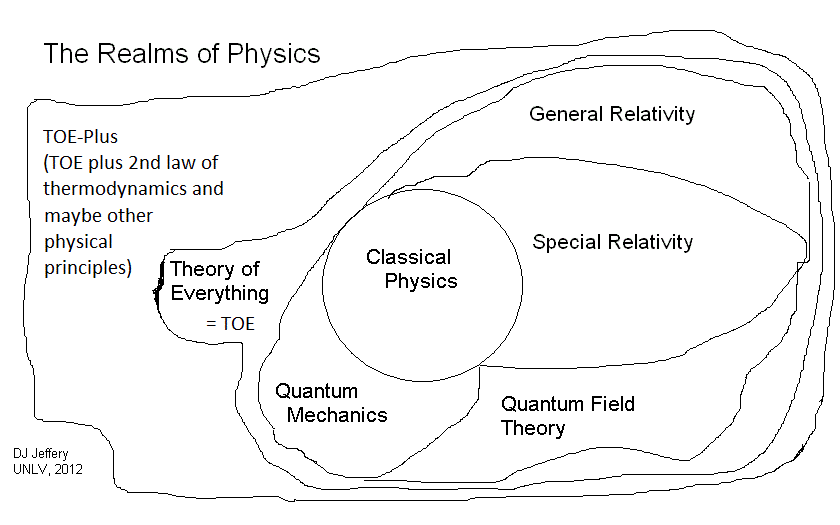
Caption: A schematic diagram of the branches of physics: i.e., the REALMS of physics.
The diagram only gives a rough idea of the relationships of the branches It is meant to be suggestive. It takes many words to give a more exact understanding of the relationships---and different people would give somewhat different understandings.
The diagram actually should have another dimension suggestive how emergence plays in---but that seems too tricky to illustrate---and so we will only discuss that below.
The theory of the branch can be regarded as an exactly true emergent theory in the limit of the branch. The branch and the branch theory have the same name and the two designations are often virtually synonyms since one usually means both when one gives the name.
The branch theories:
- Theory of Everything (TOE-Plus):
TOE-Plus is a
nonce word
yours truly invented to describe
the
Theory of Everything (TOE)
plus physical principles NOT usually included in
TOE---the
2nd law of thermodynamics
most obviously.
- Theory of Everything (TOE):
The yet unknown, fundamental
theory particle physics
which includes quantum field theory.
TOE
is independent of time
and all physical history.
TOE encompasses all the other branches---they are emergent theories in the narrow definition of emergence (as given by, e.g., Wikipedia) as well as in the broad definition of emergence (as given by yours truly).
The other branches contained in the TOE branch can be reached by taking TOE to the appropriate limiting cases.
- Classical Physics:
The branch where
Newtonian physics
(AKA classical mechanics),
classical electromagnetism,
and classical thermodynamics
(which includes the classical version
of 2nd law of thermodynamics).
This is the realm of everyday life, but also
where you are well above the
microscopic scale,
where you are well below the cosmological scale,
where relative velocities are small compared
to the vacuum light speed,
and where gravity is weak compared to
black holes.
Classical physics is a vast branch.
Before circa 1900 it was thought that maybe it was all of physics. This was NOT a very perpsicacious view since all material properties had yet to be understood. However, probably people then thought of material properties as being NOT physics---maybe they thought of them as being chemistry---but physicists were darned if they were going to leave material properties to chemists.
- Special Relativity:
The branch
of high relative velocity motions approaching
ideal vacuum light speed which is the
ultimate speed at which information can be transferred---except for rather
tricky-to-explain exceptions in
quantum mechanics
the growth of space in
general relativity.
Newtonian physics (AKA classical mechanics) is the low-velocity limit of the special-relativistic mechanics.
- Quantum Mechanics:
The branch
of microscopic physics or the
microscopic scale.
Quantum mechanics is essential to understanding atoms and molecules and how macroscopic material properties emerge from atomic and molecular behavior.
Modern electronics and your cell phone depend on quantum mechanics.
Newtonian physics is considered to be the macroscopic emergent limit of quantum mechanics. But, in fact, how it emerges in all perspectives has NOT yet been shown to the satisfaction of all people (see, e.g., Schlosser et al., 2013, A Snapshot of Foundational Attitudes Toward Quantum Mechanics).
- Quantum Field Theory:
Essentially, the branch
of relativistic quantum mechanics.
Among many other things, quantum field theory is essential to understanding the interaction of electromagnetic radiation and matter.
Quantum mechanics can be understood as the low-velolcity or low-energy emergent limit of quantum field theory.
- General Relativity:
This is the branch of
of strong gravity or somewhat weaker
gravity looked at very closely.
Special relativity Newtonian physics are the weak gravity emergent limits of general relativity.
General relativity is NOT consistent with quantum mechanics, and this is one of the reasons we know our current physics don't amount to TOE or TOE-plus.
Image link: Itself.
Local file: local link: physics_branches.html.
File: Physics file: physics_branches.html.